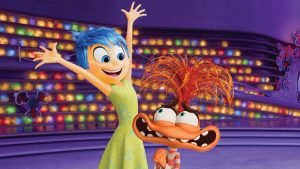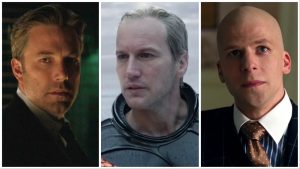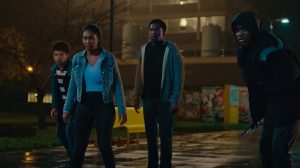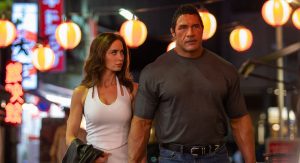
This article contains spoilers for both versions of The Crow.
The Crow (1994) is one of those seminal touchstones that help define a generation. Gothic, mournful, and haunted by the nigh literal ghost of Brandon Lee, every frame of the film can feel like it’s projected from another world. So it has always been a bit of a mystery why anyone would dare remake the cult classic, including in the mind of the original’s director, Alex Proyas. Yet since about 2008, the redo has experienced starts and stops, and seen interesting directors and castings come and go, from Norman Reedus and Kristen Stewart to Jason Momoa and Jessica Brown Findlay.
Well, The Crow remake is finally here almost 30 years to the day since Lee’s final film was released posthumously on May 13, 1994. And to director Rupert Sanders’ credit, at least insofar as this, his version of The Crow is a dramatically different reimagining of James O’Barr’s original comic book series that was first published in 1989, as well as of select elements from the Proyas/Lee original of ’94. Sanders and screenwriters Zach Baylin and William Schneider went to great lengths in order to justify walking across hallowed ground, and The Crow of 2024 is a different movie that goes to the beat of its own drum. Yet the most interesting thing about the film, then, is contrasting it with the ’94 picture and unpacking why the new version missed the music altogether in the concept.
Story Structure
The most obvious departure that makes The Crow ’24 a bird of a different feather is in how Sanders and Baylin set up their film as essentially an elongated origin story for the Crow’s titular character.
Proyas’ The Crow opens with the innocence of a child’s voice matter-of-factly explaining, “People once believed that when someone dies, a crow carries their soul to the land of the dead. But sometimes, something so bad happens that a terrible sadness is carried with it, and the soul can’t rest. And sometimes, just sometimes, the crow can bring that soul back to put the wrong things right.” The movie thus unfolds its central tenet with the simplicity of a fairytale. When the movie begins, Brandon Lee’s Eric Draven and his great love Shelly Webster (Sofia Shinas) have already been dead a year, we are here to bear witness to Draven’s resurrection as a ghost or revenant who seeks to exact a terrible vengeance over the span of just 24 hours.
Conversely, this year’s Crow takes a diametrically opposed approach to how it tells the story, departing from both the ’94 movie and James O’Barr’s original comic book. While Sanders and Baylin didn’t arrive to the long-gestating remake until 2022, the project still feels like it has roots in its original 2008 announcement. Conceptually, this movie is very much The Crow Begins in the Christopher Nolan sense. Just as how Nolan took an expansive look at why a billionaire orphan would end up dressing as a bat, the new Crow ostensibly tries to explain how a theoretically troubled young man named Eric Draven (Bill Skarsgård) and the love of his life, Shelly Webster (FKA Twigs), wind up in a tragic whirlwind romance that puts them in supernatural peril.
The Crow ’24 therefore begins with a scene of a boy named Eric experiencing a childhood trauma, much like a young Bruce Wayne in Batman Begins, although whatever Sanders in company were going for appears to have been severely pared down in the editing room. The first scene is of a child on a farm trying to help a prized horse that inexplicably is caught in barbed wire (obviously a metaphor for Shelly’s doomed soul). In the process of freeing the horse, the kid scars his hands on the wire, and the film cuts to him as an adult in a substance abuse rehabilitation center.
Whereas we are only fleetingly told in the original that Lee’s Eric Draven was some kind of grunge rock star before he died, we are supposed to at least glean Skarsgård’s Eric is a far more troubled outcast who is enduring court-mandated rehabilitation after presumably decades of trauma. He’s even got sad, emo-boy tattoos.
It is in the rehabilitation center that he’ll also meet Shelly before the two embark on a dizzying and apparently profound romantic love story before their inevitable murders. However, even their deaths figure much more predominantly in the overall plot. In the original The Crow, we learn thugs brutally assaulted, tortured, and killed Eric and Shelly because the two refused to abandon their apartment tenement that local gangsters wanted to take over and tear down. It is fairly black and white.
In addition to ostensibly grounding Eric’s backstory, The Crow ’24 is awkwardly determined to delve deeper into the metaphysical mechanics of the supernatural. In this retelling of the story, Shelly is expressly targeted due to her association with the occult, chiefly a demonic crime lord named Vincent Roeg (Danny Huston), who apparently made a deal with the Devil centuries earlier. He is granted immortality, so long as he frequently feeds Hell innocent souls by whispering into good people’s ears to do bad things. This form of soft-possession provides a one-way ticket to eternal damnation as Vincent mostly causes nice people to commit suicide. However, he used his sinister power to also urge Shelly to murder a friend for murky reasons.
So after Shelly runs off with Eric—quite literally as they escape the rehabilitation center together—she becomes Victor’s fixation for eternal punishment. She is eventually captured and swiftly murdered, along with Eric, by way of bags covering their faces. We then witness the afterlife, or at least a limbo nether-region in it, from Eric’s point-of-view. It is here that what appears to be a human manifestation of “the crow” spirit from the original film (played by Sami Bouajila in the new movie) overloads Eric and the audience with mountains of exposition: the powers-at-be (in Heaven?) do not much care for Danny Huston’s devilish kingpin, so they’re sending Eric back to the world of the living with all the powers he had from the ’94 movie for one reason: to kill Vincent and his subordinates.
In return, they initially promise that they will pull Shelly from Hell (which in the film is visualized as a murky blackness at the bottom of a bottomless ocean). But due to a further overabundance of plotting, to free Shelly from Hell, Eric must eventually agree to damn himself and go to Hell in her place after his mission is over.
All of which is to say that The Crow 2024’s desire to over-explain everything, from Eric’s motivating trauma to the mechanics of the afterlife, weighs the film down like Shelly’s soul sinking into the inky abyss. Theoretically we understand better why Draven was allowed to return from the dead, but in practice it robs a fable of its simplicity and poetry. It’s also haphazardly handled in what seems like a brutal post-production process. The viewer is given a lot of useful background on Shelly, but almost nothing about Eric (our protagonist) beyond that obligatory opening scene of him scarring his hands. Why Eric is so depressed before Shelly, or even why she is the love of his life after what seems to be just a whirlwind week of traveling between the bedroom and the tattoo shop, is elusive.
It’s a lot more plot than a revenant visiting the men who murdered him and his lover one year ago to the day. And the story is poorer for it.
A Gothic Ghost Story versus an Action Movie Programmer
Movies are more than plotlines, though, and it was never the story which makes the original Crow so haunting. Proyas’ aforementioned fairytale quality is derived from a heightened Gothic sensibility that borders on surrealism. The 1994 movie is set in a crumbling American city that looks like it’s hanging ass-backwards over the abyss even before Draven comes back from the dead.
Perpetually rain-soaked, dark, and marred by endless Gothic church spires and wires to nowhere for a supernatural crow to perch on, The Crow’s setting in the ‘90s was a hellish Neverland apropos of a time when genre films were allowed to embrace a level of artifice and unreality that’s been largely forgotten by Hollywood studios. Released a few years after Tim Burton made the first couple of Batman movies experiments in German Expressionism, and the last Alien movie better resembled a metaphorical dirge about death, The Crow ’94 does not feel the need to over-explain why Lee’s Eric Draven dons the makeup of a court jester in his second life, nor do villains like Michael Wincott’s Top Dollar need to resemble anything in the real world as they drink apparent blood from chalices.
The Crow (2024) is a strange amalgamation of influences and styles that never blend. Whatever else you can say about director Rupert Sanders, the filmmaker is a definite stylist who brought a slick Gothic quality to Snow White and the Huntsman in 2012, and at least could make his woefully misjudged Ghost in the Shell remake a visually pleasing knockoff of Ridley Scott’s first Blade Runner. Admittedly, those movies lack much visual originality and better resemble a music video director—which Sanders has been—nakedly referencing his influences with the subtlety or tact of a Meatloaf ballad… but they still looked cool if only in a superficial way.
The Crow ’24 only has a few sequences like that, and intriguingly each is scored to indie rock songs befitting a music video. One features an uplifting, folksy quality that evokes freedom when Eric and Shelly escape their rehabilitation clinic and run through the woods like they’re in an 2000s Fox Searchlight dramedy, and another finds undead Eric brooding in the blackness of night with a crow following his silhouette like they’re on the cover of a My Chemical Romance album.
But these intermittent flourishes exist in isolation and passing. Overall, the film becomes a prosaic and ugly action movie with the functionality of a dozen John Wick clones. Yet even that comparison is unfair. There’s a formalism to the way Chad Stahelski shoots the John Wick series which infuses it with charming, operatic grandeur. The Crow’s character scenes are obligatory in their point-and-shoot nature, and despite the film’s biggest action sequence taking place in a literal opera house, there is no grace or gravitas to the orchestrated violence. It is just extremely gory.
The way Proyas framed the violence of The Crow ’94 is one of that movie’s weaknesses, too, with over-edited fast cuts and flashing gunfire obviously targeting MTV audiences. But these arbitrary sequences were not the point of that movie; it was rather the commercial concession added to a film that was more interested in the brooding tragedy of Lee’s black-on-white figure crouching in the rain, or of a little girl delivering flowers to Eric and Shelly’s grave at sunset.
By contrast, the aforementioned opera sequence ends with Skarsgård’s Crow literally stealing a soprano’s flowers from the stage after delivering the severed heads of two hellbound souls to the audience. But this just betrays how tacky the movie is. Like so many Lionsgate programmers, this is a film determined to feed a niche bloodlust, but numerous shots of Skarsgård’s Crow cutting, scalping, and skewering henchmen betrays an inherent emptiness. The one exception, we’ll admit, is a few shots of the immortal protagonist using the swords put in his body by his enemies as weapons without taking them out. For instance, after being stabbed by a stuntman, the Crow lies on top of his foe and uses the same blade protruding from his chest to blind the guy. It’s surface level ugliness, but at least there it is effective.
The Man Behind the Crow’s Makeup
The elephant in the room when discussing The Crow will always be the tragic and profound loss of Brandon Lee. While the film Proyas made still would have a bleeding, pleading heart, particularly because of Lee’s seismic talents, the fact Lee also died while filming the movie when he was fatally wounded by a prop gun, gives the picture a heartbreaking eeriness. The film, both as a story and an experience for the viewer, features a ghost giving us one last beautiful, bittersweet show before returning to the other side of the river.
In this sense, it is impossible for any other performance to measure up, which is of course one of several reasons why a remake always seemed ill-advised. One can also not hold against an actor as talented and bold in his choices as Skarsgård the risk of attempting to reinterpret the character created by James O’Barr. After all, Skarsgård impressively made Pennywise the Dancing Clown his own after Tim Curry previously gave a fairly iconic interpretation of the Stephen King monster.
Still, it seems that for better and worse Sanders, Baylin, and Skarsgård elected to do an almost entirely different character from the one Lee created. But the comparisons still leave the reinvention wanting.
Because The Crow ’24 is an extended origin story, Skarsgård is not really playing even a version of what we see Lee become until the new movie’s last 35 or so minutes. While Skarsgård’s Draven is murdered at about the 45-minute mark, he is still just a man in grief and unaware of how to take advantage of the superpowers he has. Furthermore, the film is probably at its strongest when it is just about the connection he feels to Shelly.
While the new film descends into action movie clichés, complete with a stock villain, there are moments of inspiration in the performances during the extended montages composing Eric and Shelly’s love story. This is not to say that the love story fully works unto itself. Viewers get the sense that these two crazy kids are high off infatuation and the thrill of escaping old lives. But the chemistry between Skarsgård and FKA Twigs is genuine, and you enjoy seeing these two people happy.
With that said, Skarsgård’s Eric is written and played as a much more dour and self-loathing individual. The obligatory opening scene establishes he has past trauma, and Skarsgård portrays him as a damaged, introverted soul who would rather be alone except for Shelly. After she dies, he is simply the grieving boyfriend in a bad haircut. Only in the third act, does he get to reinterpret what Lee did. This occurs after he makes a deal with the humanized Crow spirit. Eric will trade his soul for Shelly’s in Hell, and as a consequence, his blood turns black and he seems to grow the harlequin jester makeup around his eyes and lips as if it were his own flesh.
This is where the movie indulges in all the needless gore and gunplay, and Skarsgård at last has some meat to pick at other than cautious joy and bland sadness. There is at last a real ferocity in his eyes, which in the face of a clown scared millions of moviegoers only a few years ago. But as is accurately called out by the film’s screenplay, there is an overriding anger and despair there. One of his victims even boringly says he’s exactly like the film’s demonic villain: “You both hate yourselves, he just hides it better.”
Skarsgård’s Crow is, eventually, a solidly played riff on the revenger’s tragedy at its most generic. To avenge Shelly, he loses his soul, literally and figuratively, and is just another hollowed out bad boy who will go to hell to punish the evildoers. In effect, it is the same archetype action movies have been running into the ground since Charles Bronson’s heyday.
Which brings us back to Lee. The past life of Lee’s Eric is a lot less defined. We know he and his fiancée had an idyllic life before their murders (his Shelly is also the most quintessential “fridged girlfriend”). However, Lee nor Proyas never frame this Crow’s tragedy as deriving from a quest for revenge.
The tragedy is entirely informed by the loss Eric experienced. His quest for vengeance is nothing less than just or righteous. Much like the comic book the film is based on—O’Barr created this character after losing his fiancée to a drunk driver—The Crow ’94 is a metaphor for grief. Killing the men responsible is about the hero working through his sorrow; that bad guys die is almost incidental to his feelings of loneliness, longing, and loss.
All of that is in Lee’s performance, which unlike Skarsgård’s, is afforded scenes of playing off other characters Eric has an actual history or connection with. There is the little girl who adored Eric and Shelly, Sarah (Rochelle Davis); there is also the copper who showed pity on Shelly and whose goodness Eric/the Crow literally taps into as he sees through the eyes of Sgt. Daryl Albrecht (Ernie Hudson). There are scenes of joy, if bitterly so, in these interactions that add texture and a soul to our avenging angel.
He also can relish living again. In the ’94 movie, after realizing he’s returned from the dead, Lee’s Eric embraces the Gothic absurdity of his plight by mirroring the masks of both sorrow and laughter that any other actor would recognize. What little we know about him before death is that he was a rockstar. Well, in his afterlife he is still a helluva showman with the Crow’s theatrical appearance being an intentional performance and affectation—and it is one he visibly enjoys. He even quotes Edgar Allan Poe while speaking of his spirit crow.
Behind his guy-liner, Lee’s Draven can grieve and hate, but he can also laugh, smile, and savor his role as a ghost. Even though he’s dead, there is still a passion for life. The intertextual knowledge that Lee also had such a passion for life, and would, like his character, lose it all too soon, adds untold layers of tragedy and wistfulness to the performance.
It is something that really cannot be duplicated. Nor should you even try. In their own way, the filmmakers of The Crow 2024 recognized that impossible task and attempted to evade it. But in which case, is the new movie even The Crow? We would argue not, which makes its existence all the more mystifying.
The post The Crow (1994) vs. The Crow (2024): The Differences Between Greatness and Not appeared first on Den of Geek.






